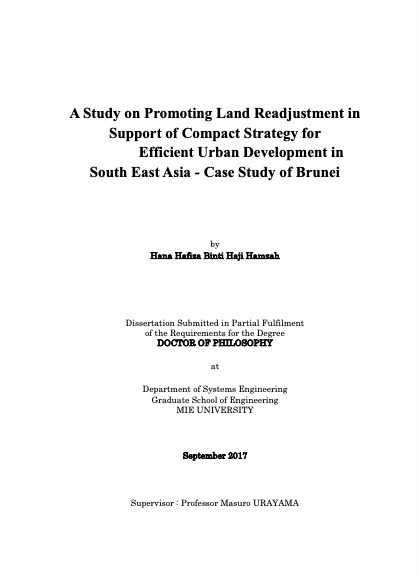Resource information
Countries in South-East Asia are experiencing rapid urbanisation and Land Readjustment is one of the potential methods of land development that could help solve some of the urban problems such as urban sprawl and inadequate infrastructure. While Land Readjustment is beneficial, it is often very complex particularly for developing countries to undertake due to the weak institutional system and also lack of technology.
The aim of this research is to provide a framework that would guide South-East Asian countries to initiate and consequently promote Land Readjustment practice for efficient urban development under the present rapid urbanisation. This thesis utilises a case study approach with Brunei selected as the case study area. Brunei is currently trying to manage its urban growth through the introduction of a compact strategy under its latest National Land Use Master Plan. The compact strategy proposed that new developments to be contained within a defined area (Urban Footprint Zone) and that land to be used more efficiently through high density and infill developments.
Through an empirical analysis of the existing developments in both the public and private housing, it was found that most housing developments are contained within the designated Urban footprint zone. The new housings are mainly located within existing developed areas (infill) and housing type has shifted towards higher density through a change in design and reduction in land size. However, due to the non-statutory nature of the Master plan, developments continue to occur outside the Urban Footprint zone. In addition, the analysis also shows that the existing land allocation can further hinder the success of the strategy. Within the Urban Footprint Zone, there exist many lands that are irregularly shaped, fragmented/ scattered, and lacking in accessibility. This would inevitably lead to the inefficient use of land. The existing planning & development system is insufficient to solve these land issues and thus there is a need to undertake Land Readjustment.
A review of the land readjustment practices in Brunei and Thailand was done to identify the issues of land readjustment implementation and measures adopted to promote the projects. The analysis on Brunei’s Land Readjustment project found that without a specific law, Phase I of the project was able to be implemented. This was due to strong government support, good project location and clear benefits to land owners. However, Phase II is still ongoing since the year 2005. The factors that have affected the delay of the projects were design, negotiation approach, land issues and funding. A second analysis was undertaken for Thailand, the only country in Southeast Asia that has established a formal Land Readjustment System. This analysis found that in the absence of law, a simpler approach of replotting and low contribution rate is important. In the presence of law, measures such as financial support and necessity of evaluation have been introduced to promote projects. Clear processes and procedures were also able to be established based on the Land Readjustment Law.
The final part of this thesis provides the recommendation for initiating a Land Readjustment project under different settings. In the absence of law, simple replotting should be undertaken with strong government support. Sales of reserve land will be the main source of financing, however, other financing options should be reviewed. The location of projects should thus be limited to areas of high development potential. In the presence of the law, adopting an evaluation system is necessary to ensure equity among landowners. Similarly, various financing options should be available. However, government support is much anticipated particularly for areas that has less demand for development. Therefore, it is preferred that selection of the area be in line with existing Master plan proposal to enable some form of subsidy to be provided.

